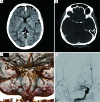Multi-modal CT scanning in the evaluation of cerebrovascular disease patients
- PMID: 25009794
- PMCID: PMC4069983
- DOI: 10.3978/j.issn.2223-3652.2014.06.05
Multi-modal CT scanning in the evaluation of cerebrovascular disease patients
Abstract
Ischemic stroke currently represents one of the leading causes of severe disability and mortality in the Western World. Until now, angiography was the most used imaging technique for the detection of the extra-cranial and intracranial vessel pathology. Currently, however, non-invasive imaging tool like ultrasound (US), magnetic resonance (MR) and computed tomography (CT) have proven capable of offering a detailed analysis of the vascular system. CT in particular represents an advanced system to explore the pathology of carotid arteries and intracranial vessels and also offers tools like CT perfusion (CTP) that provides valuable information of the brain's vascular physiology by increasing the stroke diagnostic. In this review, our purpose is to discuss stroke risk prediction and detection using CT.
Keywords: CT perfusion (CTP); CT-angiography (CTA); Computed tomography (CT); carotid artery; stroke; vulnerable plaque.
Figures













References
-
- Kim AS, Johnston SC. Global variation in the relative burden of stroke and ischemic heart disease. Circulation 2011;124:314-23 - PubMed
-
- Saposnik G, Kapral MK, Liu Y, et al. IScore: a risk score to predict death early after hospitalization for an acute ischemic stroke. Circulation 2011;123:739-49 - PubMed
-
- Saba L, Sanfilippo R, Pirisi R, et al. Multidetector-row CT angiography in the study of atherosclerotic carotid arteries. Neuroradiology 2007;49:623-37 - PubMed
-
- Saba L, Montisci R, Sanfilippo R, et al. Multidetector row CT of the brain and carotid artery: a correlative analysis. Clin Radiol 2009;64:767-78 - PubMed
-
- Saba L, Potters F, van der Lugt A, et al. Imaging of the fibrous cap in atherosclerotic carotid plaque. Cardiovasc Intervent Radiol 2010;33:681-9 - PubMed
Publication types
LinkOut - more resources
Full Text Sources
